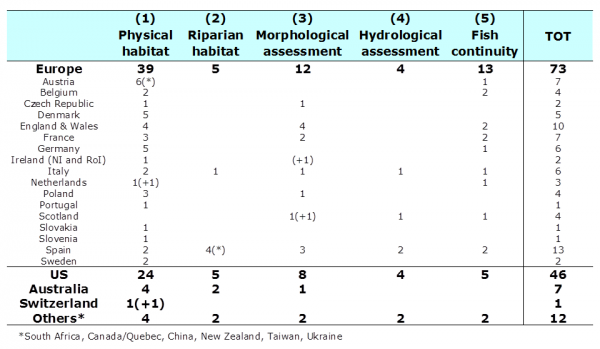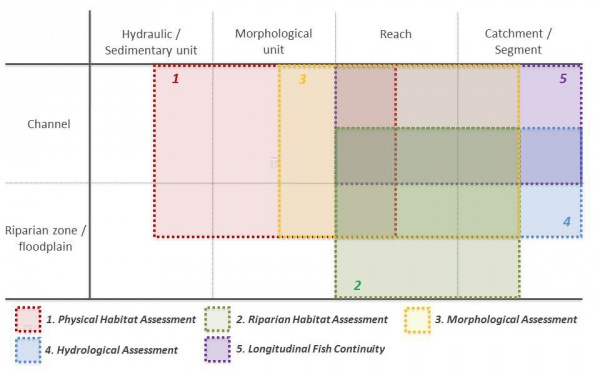Difference between revisions of "Category:Hydromorphological assessment methods"
(→Introduction) |
(→Recommendations for future progress) |
||
| (10 intermediate revisions by 3 users not shown) | |||
| Line 1: | Line 1: | ||
| − | |||
[[Category:Tools]] | [[Category:Tools]] | ||
| + | |||
== Introduction == | == Introduction == | ||
We performed a literature review of existing hydromorphological (HYMO) methods (indicators, tools and models) used in river management and restoration aiming to identify ecologically relevant physical structures on different spatial and temporal scales. To understand and predict eco-hydromorphological responses to man-made physical change. | We performed a literature review of existing hydromorphological (HYMO) methods (indicators, tools and models) used in river management and restoration aiming to identify ecologically relevant physical structures on different spatial and temporal scales. To understand and predict eco-hydromorphological responses to man-made physical change. | ||
== Categories of HYMO methods == | == Categories of HYMO methods == | ||
| − | Hydromorphological assessment methods have been divided into 5 categories: | + | Hydromorphological assessment methods have been divided into 5 categories (see pages below): |
| − | # ''Physical | + | # ''Physical habitat assessment'' |
# ''Riparian habitat assessment'' | # ''Riparian habitat assessment'' | ||
# ''Morphological assessment'' | # ''Morphological assessment'' | ||
# ''Hydrological regime assessment'' | # ''Hydrological regime assessment'' | ||
# ''Fish longitudinal continuity assessment?'' | # ''Fish longitudinal continuity assessment?'' | ||
| − | This distinction in categories allows comparison of methods which focus on similar aspects and are applied at comparable spatial scales (i.e. site, reach, catchment) and contexts (e.g. river channel, riparian areas, floodplain). A more detailed analysis of the methods used by European countries for the implementation of the WFD was also carried out. In total 139 methods (European and non-European countries) were reviewed. | + | This distinction in categories allows comparison of methods which focus on similar aspects and are applied at comparable spatial scales (i.e. site, reach, catchment) and contexts (e.g. river channel, riparian areas, floodplain) (Figure 1). |
| + | |||
| + | [[File:CategoriesHYMOmethods clip.jpg|center|thumb|600px| Figure 1. Spatial context, spatial scales and overlap between assessment method categories. | ||
| + | ]] | ||
| + | |||
| + | A more detailed analysis of the methods used by European countries for the implementation of the WFD was also carried out. In total 139 methods (European and non-European countries) were reviewed (Table 1). | ||
| − | [[File: | + | [[File:TableMethodsReviewed_clip.png|center|thumb|600px| Table 1. Summary of reviewed methods for each category. For methods (1): Netherlands (+1) means that they apply an additional method (the Austrian GEBD; Buhmann & Hutter, 1996); Austria (*) and Switzerland (+1) mean that RATyrol (BUWAL, 1998) is used in both countries. For methods (2): Spain (*) means that the QBR (Munné & Prat, 1998) is also applied in Greece. For methods (3): Ireland (+1) and Scotland (+1) mean that they additionally apply the English Stream Reconnaissance Handbook by Thorne (1998). |
]] | ]] | ||
== Recommendations for future progress == | == Recommendations for future progress == | ||
| − | The main recommendations for future progress for eco-hydromorphological assessment are the following: | + | The main recommendations for future progress for eco-hydromorphological assessment are the following: |
| + | # To improve the understanding of the relationship between organisms and hydromorphological pressures; | ||
| + | # The need of process-based assessment methods; | ||
| + | # The identification of appropriate spatial and temporal scales for the application of the assessment methods and for linking processes by a hierarchical spatial framework; | ||
| + | # The identification of the most suitable methods, by including all the components of hydromorphological conditions (morphology, hydrology, physical and riparian habitats, longitudinal continuity for fish), by testing and adapting them to other European contexts; | ||
| + | # The need for improving physical habitat assessment by including a geomorphologically-based survey in terms of techniques and improved terminology; | ||
| + | # To provide a practical and simple initial screening tool to identify critical hydromorphological conditions at catchment scale. | ||
Latest revision as of 14:49, 7 January 2019
Introduction
We performed a literature review of existing hydromorphological (HYMO) methods (indicators, tools and models) used in river management and restoration aiming to identify ecologically relevant physical structures on different spatial and temporal scales. To understand and predict eco-hydromorphological responses to man-made physical change.
Categories of HYMO methods
Hydromorphological assessment methods have been divided into 5 categories (see pages below):
- Physical habitat assessment
- Riparian habitat assessment
- Morphological assessment
- Hydrological regime assessment
- Fish longitudinal continuity assessment?
This distinction in categories allows comparison of methods which focus on similar aspects and are applied at comparable spatial scales (i.e. site, reach, catchment) and contexts (e.g. river channel, riparian areas, floodplain) (Figure 1).
A more detailed analysis of the methods used by European countries for the implementation of the WFD was also carried out. In total 139 methods (European and non-European countries) were reviewed (Table 1).

Recommendations for future progress
The main recommendations for future progress for eco-hydromorphological assessment are the following:
- To improve the understanding of the relationship between organisms and hydromorphological pressures;
- The need of process-based assessment methods;
- The identification of appropriate spatial and temporal scales for the application of the assessment methods and for linking processes by a hierarchical spatial framework;
- The identification of the most suitable methods, by including all the components of hydromorphological conditions (morphology, hydrology, physical and riparian habitats, longitudinal continuity for fish), by testing and adapting them to other European contexts;
- The need for improving physical habitat assessment by including a geomorphologically-based survey in terms of techniques and improved terminology;
- To provide a practical and simple initial screening tool to identify critical hydromorphological conditions at catchment scale.
Pages in category "Hydromorphological assessment methods"
The following 6 pages are in this category, out of 6 total.
